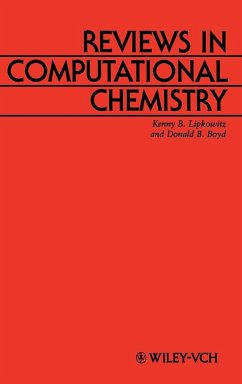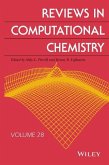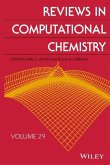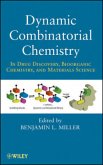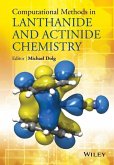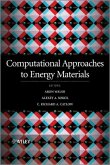Kenny B. Lipkowitz / Donald B. Boyd (Hgg.)
Reviews in Computational Chemistry, Volume 1
Herausgegeben von Lipkowitz, Kenny B.; Boyd, Donald B.
Kenny B. Lipkowitz / Donald B. Boyd (Hgg.)
Reviews in Computational Chemistry, Volume 1
Herausgegeben von Lipkowitz, Kenny B.; Boyd, Donald B.
- Gebundenes Buch
- Merkliste
- Auf die Merkliste
- Bewerten Bewerten
- Teilen
- Produkt teilen
- Produkterinnerung
- Produkterinnerung
This book is an account of current developments in computational chemistry, a new multidisciplinary area of research. Experts in computational chemistry, the editors use and develop techniques for computer-assisted molecular design. The core of the text itself deals with techniques for computer-assisted molecular design. The book is suitable for both beginners and experts. In addition, protocols and software for molecular recognition and the relationship between structure and biological activity of drug molecules are discussed in detail. Each chapter includes a mini-tutorial, as well as…mehr
Andere Kunden interessierten sich auch für
![Reviews in Computational Chemistry, Volume 28 Reviews in Computational Chemistry, Volume 28]() Reviews in Computational Chemistry, Volume 28237,99 €
Reviews in Computational Chemistry, Volume 28237,99 €![Reviews in Computational Chemistry, Volume 8 Reviews in Computational Chemistry, Volume 8]() Kenny B. Lipkowitz / Donald B. Boyd (Hgg.)Reviews in Computational Chemistry, Volume 8376,99 €
Kenny B. Lipkowitz / Donald B. Boyd (Hgg.)Reviews in Computational Chemistry, Volume 8376,99 €![Reviews in Computational Chemistry, Volume 29 Reviews in Computational Chemistry, Volume 29]() Reviews in Computational Chemistry, Volume 29228,99 €
Reviews in Computational Chemistry, Volume 29228,99 €![Dynamic Combinatorial Chemistry Dynamic Combinatorial Chemistry]() Dynamic Combinatorial Chemistry122,99 €
Dynamic Combinatorial Chemistry122,99 €![Computer Software Applications in Chemistry Computer Software Applications in Chemistry]() Peter C. JursComputer Software Applications in Chemistry221,99 €
Peter C. JursComputer Software Applications in Chemistry221,99 €![Computational Methods in Lanthanide and Actinide Chemistry Computational Methods in Lanthanide and Actinide Chemistry]() Computational Methods in Lanthanide and Actinide Chemistry252,99 €
Computational Methods in Lanthanide and Actinide Chemistry252,99 €![Computational Approaches to Energy Materials Computational Approaches to Energy Materials]() Richard CatlowComputational Approaches to Energy Materials188,99 €
Richard CatlowComputational Approaches to Energy Materials188,99 €-
-
-
This book is an account of current developments in computational chemistry, a new multidisciplinary area of research. Experts in computational chemistry, the editors use and develop techniques for computer-assisted molecular design. The core of the text itself deals with techniques for computer-assisted molecular design. The book is suitable for both beginners and experts.
In addition, protocols and software for molecular recognition and the relationship between structure and biological activity of drug molecules are discussed in detail. Each chapter includes a mini-tutorial, as well as discussion of advanced topics.
Special Feature: The appendix to this book contains an extensive list of available software for molecular modeling.
Hinweis: Dieser Artikel kann nur an eine deutsche Lieferadresse ausgeliefert werden.
In addition, protocols and software for molecular recognition and the relationship between structure and biological activity of drug molecules are discussed in detail. Each chapter includes a mini-tutorial, as well as discussion of advanced topics.
Special Feature: The appendix to this book contains an extensive list of available software for molecular modeling.
Hinweis: Dieser Artikel kann nur an eine deutsche Lieferadresse ausgeliefert werden.
Produktdetails
- Produktdetails
- Reviews in Computational Chemistry Vol.1
- Verlag: Wiley & Sons
- 1. Auflage
- Seitenzahl: 440
- Erscheinungstermin: 17. Dezember 1996
- Englisch
- Abmessung: 240mm x 161mm x 28mm
- Gewicht: 709g
- ISBN-13: 9780471187288
- ISBN-10: 0471187283
- Artikelnr.: 22138162
- Herstellerkennzeichnung
- Libri GmbH
- Europaallee 1
- 36244 Bad Hersfeld
- gpsr@libri.de
- Reviews in Computational Chemistry Vol.1
- Verlag: Wiley & Sons
- 1. Auflage
- Seitenzahl: 440
- Erscheinungstermin: 17. Dezember 1996
- Englisch
- Abmessung: 240mm x 161mm x 28mm
- Gewicht: 709g
- ISBN-13: 9780471187288
- ISBN-10: 0471187283
- Artikelnr.: 22138162
- Herstellerkennzeichnung
- Libri GmbH
- Europaallee 1
- 36244 Bad Hersfeld
- gpsr@libri.de
Kenny B. Lipkowitz, PhD, is a retired Professor of Chemistry from North Dakota State University. Donald B. Boyd was apponted Research Professor of Chemistry at Indiana University - Purdue University Indianapolis in 1994. He has published over 100 refereed journal papers and book chapters.
1. Basis Sets for Ab Initio Molecular Orbital Calculations and
Intermolecular Interactions 1
David Feller and Ernest R. Davidson
Introduction 1
Some Terminology 4
Gaussian Compared to Exponential Functions 4
Contracted Gaussians 4
Polarization Functions 7
Complete Sets 8
The Basis Set Superposition Error 9
Choosing a Basis Set 10
Molecular Geometries 11
Energy Differences 15
One-Electron Properties 20
In-Depth Discussion 20
Sources of Gaussian Primitives and Contraction Coefficients 20
Even-Tempered Gaussians 21
Well-Tempered Gaussians 22
MINI-/, MIDI-/ and MAXI-/ etc. 26
Still Others 27
Atomic Natural Orbitals 27
Functions for Augmenting Basis Sets 29
Weak Interactions 34
Conclusion 36
References 37
2. Semiempirical Molecular Orbital Methods 45
James J. P. Stewart
Introduction 45
History of Semiempirical Methods 46
Complete Neglect of Differential Overlap 47
Complete Neglect of Differential Overlap Version 2 50
Intermediate Neglect of Differential Overlap 51
Neglect of Diatomic Differential Overlap (NDDO) 52
Modified Neglect of Diatomic Overlap 55
Austin Model 1 57
Parametric Method Number 3 58
Self-Consistent Field Convergers 58
Strong and Weak Points of NDDO Semiempirical Methods 61
MINDO/3 62
MNDO, AMI, and PM3 62
Theoretical Experiments 73
Stationary Points 74
General Procedure for Characterizing a Reaction 74
Reaction Path 75
Time-Dependent Phenomena 76
Future of Semiempirical Methods 77
Summary 78
References 78
3. Properties of Molecules by Direct Calculation 83
Clifford E. Dykstra, Joseph D. Augspurger, Bernard Kirtman, and David J.
Malik
Introduction 83
Overview of Quantum Mechanical Properties 84
Correspondence between Energy Derivatives and Properties 84
Differentiation of the Schrodinger Equation 85
The Development of Methods for Property Determinations 87
Semiempirical Approaches 87
Ab Initio Methods 89
Detailed View of Ab Initio Methods 92
Hamiltonians and Operators 92
Computational Organization of the Differentiation Process 95
Derivatives of Electronic Wavefunctions 97
Local Space Concepts for Extended Systems 99
Vibrations and Rotations 100
Direct Property Calculations 103
Electrical Properties 103
Magnetic Properties 107
Force Constants 109
Transition Probabilities and Optical Properties 110
Summary 111
References 112
4. The Application of Quantitative Design Strategies in Pesticide Discovery
119
Ernest L. Plummer
Introduction 119
The Selection of a Strategy 122
The Well-Designed Substituent Set 126
The Ideal Substituent Set Should Cover All Factors That Control Activity
127
The Ideal Substituent Set Should Cover the Selected Factor Space as
Completely as Possible 128
The Ideal Substituent Set Should Span Orthogonal Dimensions of Parameter
Space 129
The Ideal Set Should Contain the Minimum Number of Substituents Necessary
to Avoid Chance Correlations and Still Meet the Desired Goal 130
Target Compounds Should Be Chosen to Preserve Synthetic Resources But
Should Not Be Chosen Just Because They Are Easy to Synthesize 131
The Derivatives Must Be Stable under the Conditions of Bioevaluation 131
Analysis Strategies 132
The Topliss Tree 132
Free-Wilson Analysis 135
A Strategy for Lead Optimization Using Multiple Linear Regression Analysis
138
Choose the Optimal Pattern for Substitution 139
Choose the Factors (Parameters) That Are Likely to Be Important 142
Select a Substituent Set 143
Synthesize and Submit for Biological Evaluation 152
Plot Each Parameter versus Activity 154
Generate Squared Terms if Justified by the Single Parameter Plots 157
Run All Combinations of the Chosen Parameters through Linear Regression
Analysis to the Limits of Statistical Significance 158
Repeat the Process Until the QSAR Is Stable 160
Sequential Simplex Optimization (SSO) 161
Conclusion 164
References 165
5. Chemometrics and Multivariate Analysis in Analytical Chemistry 169
Peter C. Jurs
Introduction 169
Response Surfaces, Sampling, and Optimization 170
Signal Processing 173
Principal Components Analysis and Factor Analysis 175
Calibration and Mixture Analysis 178
Classification and Clustering 182
Classification 183
Clustering 184
Library Searching 186
Molecular Structure-Property Relationships 188
Gas Chromatographic Retention Indices for Diverse Drug Compounds 192
Simulation of Carbon-13 Nuclear Magnetic Resonance Spectra of
Methyl-Substituted Norbornan-2-ols 198
Summary and Conclusions 207
References 208
6. Searching Databases of Three-Dimensional Structures 213
Yvonne C. Martin, Mark G. Bures, and Peter Willet
Why Are Such Methods Needed? 213
Tools for Searching Two-Dimensional Chemical Structures of Small Molecules
217
Computer Representation of Two-Dimensional Chemical Structures 218
Searching Files of Two-Dimensional Chemical Structures 220 Languages for
Chemical Programming 222
System Design for Chemical Information Systems 224
Similarity of Small Molecules Based on Two-Dimensional Structure 225
Substituent Effects on Molecular Properties 225
Two-Dimensional Topological Descriptors of Molecular Shape 226
Similarity of Small Molecules Based on Three-Dimensional Structure 226
Three-Dimensional Similarity Based on Geometric Properties 227
Three-Dimensional Similarity Based on Steric Properties 231
Databases of Three-Dimensional Structures of Molecules 234
Searching Files of Three-Dimensional Structures of Small Molecules 236
Programs from the Cambridge Crystallographic Data Centre 236
Searching Based Principally on Shape Properties 237
Strategies Based on Screen Searching 238
Strategies Based on a Substructure Specification Language 243
Databases and Searching of Multiple Three-Dimensional Pharmacophoric
Patterns 248
Searching Files of Three-Dimensional Protein Structures 249
The Protein Data Bank 249
Identification of Patterns of Atoms 249
Identification of Secondary Structure Motifs 252
Conclusions 253
Appendix: Sources of Databases and Programs 255
References 256
7. Molecular Surfaces 265
Paul G. Mezey
Introduction 265
Molecular Body and Molecular Surface 266
Classical Models for Molecular Surfaces: Hard Spheres and van der Waals
Surfaces (VDWSs) 267
Electron Density Contour Surfaces 269
The Density Domain Approach to Chemical Bonding (DDA) 271
Molecular Electrostatic Potential 274
Molecular Orbitals 276
Solvent Accessible Surfaces 278
Union Surfaces 279
Interpenetration of Molecular Contour Surfaces 281
Shape Analysis of Molecular Surfaces 282
Conclusions 288
References 289
8. Computer Simulation of Biomolecular Systems Using Molecular Dynamics and
Free Energy Peturbation Methods 295
Terry P. Lybrand
Introduction 295
Models 296
Methods 297
Energy Minimization 298
Normal Mode Analysis 298
Monte Carlo 299
Molecular Dynamics 300
Free Energy Pertubation Methods 308
Summary 314
References 315
9. Aspects of Molecular Modeling 321
Donald B. Boyd
Introduction 321
Quantum Mechanics 323
Why Use Quantum Mechanics? 323
Theory 325
Approximations 326
Comparison of Ab Initio and Semiempirical MO Methods 328
Input 329
Output 331
Basis Sets for Ab Initio Calculations 332
Caveats on Basis Sets 334
Post-Hartree-Fock Treatments 334
Selection of an MO Method 336
Numerical Sensitivity of Geometry Optimization Procedures 337
Quality of Results from Quantum Mechanical Methods 339
Information from X-Ray Databases for Molecular Modeling 341
Standard Geometries 345
Distance Geometry 345
Summary 348
References 351
10. Successes of Computer-Assisted Molecular Design 355
Donald B. Boyd
Levels of Success 355
Norfloxacin 359
Metamitron 360
Bromobutide 361
Myclobutanil 362
Conclusion 364
References 365
11. Perspectives on Ab Initio Calculations 373
Ernest R. Davidson
Atomic Orbitals Do Not Work 375
The Error in 'P Is Largest Where 'P Is Largest 376
The Number of Electron Pairs Is N(N - l)/2 377
The Computer Cost, at Fixed Accuracy, Grows Like N! 378
Computers Do Not Solve Problems, People Do 379
Appendix: Compendium of Software for Molecular Modeling 383
Donald B. Boyd
Personal Computers 384
Minicomputers-Superminicomputers-Workstations 387
Supercomputers 392
Subject Index 393
Intermolecular Interactions 1
David Feller and Ernest R. Davidson
Introduction 1
Some Terminology 4
Gaussian Compared to Exponential Functions 4
Contracted Gaussians 4
Polarization Functions 7
Complete Sets 8
The Basis Set Superposition Error 9
Choosing a Basis Set 10
Molecular Geometries 11
Energy Differences 15
One-Electron Properties 20
In-Depth Discussion 20
Sources of Gaussian Primitives and Contraction Coefficients 20
Even-Tempered Gaussians 21
Well-Tempered Gaussians 22
MINI-/, MIDI-/ and MAXI-/ etc. 26
Still Others 27
Atomic Natural Orbitals 27
Functions for Augmenting Basis Sets 29
Weak Interactions 34
Conclusion 36
References 37
2. Semiempirical Molecular Orbital Methods 45
James J. P. Stewart
Introduction 45
History of Semiempirical Methods 46
Complete Neglect of Differential Overlap 47
Complete Neglect of Differential Overlap Version 2 50
Intermediate Neglect of Differential Overlap 51
Neglect of Diatomic Differential Overlap (NDDO) 52
Modified Neglect of Diatomic Overlap 55
Austin Model 1 57
Parametric Method Number 3 58
Self-Consistent Field Convergers 58
Strong and Weak Points of NDDO Semiempirical Methods 61
MINDO/3 62
MNDO, AMI, and PM3 62
Theoretical Experiments 73
Stationary Points 74
General Procedure for Characterizing a Reaction 74
Reaction Path 75
Time-Dependent Phenomena 76
Future of Semiempirical Methods 77
Summary 78
References 78
3. Properties of Molecules by Direct Calculation 83
Clifford E. Dykstra, Joseph D. Augspurger, Bernard Kirtman, and David J.
Malik
Introduction 83
Overview of Quantum Mechanical Properties 84
Correspondence between Energy Derivatives and Properties 84
Differentiation of the Schrodinger Equation 85
The Development of Methods for Property Determinations 87
Semiempirical Approaches 87
Ab Initio Methods 89
Detailed View of Ab Initio Methods 92
Hamiltonians and Operators 92
Computational Organization of the Differentiation Process 95
Derivatives of Electronic Wavefunctions 97
Local Space Concepts for Extended Systems 99
Vibrations and Rotations 100
Direct Property Calculations 103
Electrical Properties 103
Magnetic Properties 107
Force Constants 109
Transition Probabilities and Optical Properties 110
Summary 111
References 112
4. The Application of Quantitative Design Strategies in Pesticide Discovery
119
Ernest L. Plummer
Introduction 119
The Selection of a Strategy 122
The Well-Designed Substituent Set 126
The Ideal Substituent Set Should Cover All Factors That Control Activity
127
The Ideal Substituent Set Should Cover the Selected Factor Space as
Completely as Possible 128
The Ideal Substituent Set Should Span Orthogonal Dimensions of Parameter
Space 129
The Ideal Set Should Contain the Minimum Number of Substituents Necessary
to Avoid Chance Correlations and Still Meet the Desired Goal 130
Target Compounds Should Be Chosen to Preserve Synthetic Resources But
Should Not Be Chosen Just Because They Are Easy to Synthesize 131
The Derivatives Must Be Stable under the Conditions of Bioevaluation 131
Analysis Strategies 132
The Topliss Tree 132
Free-Wilson Analysis 135
A Strategy for Lead Optimization Using Multiple Linear Regression Analysis
138
Choose the Optimal Pattern for Substitution 139
Choose the Factors (Parameters) That Are Likely to Be Important 142
Select a Substituent Set 143
Synthesize and Submit for Biological Evaluation 152
Plot Each Parameter versus Activity 154
Generate Squared Terms if Justified by the Single Parameter Plots 157
Run All Combinations of the Chosen Parameters through Linear Regression
Analysis to the Limits of Statistical Significance 158
Repeat the Process Until the QSAR Is Stable 160
Sequential Simplex Optimization (SSO) 161
Conclusion 164
References 165
5. Chemometrics and Multivariate Analysis in Analytical Chemistry 169
Peter C. Jurs
Introduction 169
Response Surfaces, Sampling, and Optimization 170
Signal Processing 173
Principal Components Analysis and Factor Analysis 175
Calibration and Mixture Analysis 178
Classification and Clustering 182
Classification 183
Clustering 184
Library Searching 186
Molecular Structure-Property Relationships 188
Gas Chromatographic Retention Indices for Diverse Drug Compounds 192
Simulation of Carbon-13 Nuclear Magnetic Resonance Spectra of
Methyl-Substituted Norbornan-2-ols 198
Summary and Conclusions 207
References 208
6. Searching Databases of Three-Dimensional Structures 213
Yvonne C. Martin, Mark G. Bures, and Peter Willet
Why Are Such Methods Needed? 213
Tools for Searching Two-Dimensional Chemical Structures of Small Molecules
217
Computer Representation of Two-Dimensional Chemical Structures 218
Searching Files of Two-Dimensional Chemical Structures 220 Languages for
Chemical Programming 222
System Design for Chemical Information Systems 224
Similarity of Small Molecules Based on Two-Dimensional Structure 225
Substituent Effects on Molecular Properties 225
Two-Dimensional Topological Descriptors of Molecular Shape 226
Similarity of Small Molecules Based on Three-Dimensional Structure 226
Three-Dimensional Similarity Based on Geometric Properties 227
Three-Dimensional Similarity Based on Steric Properties 231
Databases of Three-Dimensional Structures of Molecules 234
Searching Files of Three-Dimensional Structures of Small Molecules 236
Programs from the Cambridge Crystallographic Data Centre 236
Searching Based Principally on Shape Properties 237
Strategies Based on Screen Searching 238
Strategies Based on a Substructure Specification Language 243
Databases and Searching of Multiple Three-Dimensional Pharmacophoric
Patterns 248
Searching Files of Three-Dimensional Protein Structures 249
The Protein Data Bank 249
Identification of Patterns of Atoms 249
Identification of Secondary Structure Motifs 252
Conclusions 253
Appendix: Sources of Databases and Programs 255
References 256
7. Molecular Surfaces 265
Paul G. Mezey
Introduction 265
Molecular Body and Molecular Surface 266
Classical Models for Molecular Surfaces: Hard Spheres and van der Waals
Surfaces (VDWSs) 267
Electron Density Contour Surfaces 269
The Density Domain Approach to Chemical Bonding (DDA) 271
Molecular Electrostatic Potential 274
Molecular Orbitals 276
Solvent Accessible Surfaces 278
Union Surfaces 279
Interpenetration of Molecular Contour Surfaces 281
Shape Analysis of Molecular Surfaces 282
Conclusions 288
References 289
8. Computer Simulation of Biomolecular Systems Using Molecular Dynamics and
Free Energy Peturbation Methods 295
Terry P. Lybrand
Introduction 295
Models 296
Methods 297
Energy Minimization 298
Normal Mode Analysis 298
Monte Carlo 299
Molecular Dynamics 300
Free Energy Pertubation Methods 308
Summary 314
References 315
9. Aspects of Molecular Modeling 321
Donald B. Boyd
Introduction 321
Quantum Mechanics 323
Why Use Quantum Mechanics? 323
Theory 325
Approximations 326
Comparison of Ab Initio and Semiempirical MO Methods 328
Input 329
Output 331
Basis Sets for Ab Initio Calculations 332
Caveats on Basis Sets 334
Post-Hartree-Fock Treatments 334
Selection of an MO Method 336
Numerical Sensitivity of Geometry Optimization Procedures 337
Quality of Results from Quantum Mechanical Methods 339
Information from X-Ray Databases for Molecular Modeling 341
Standard Geometries 345
Distance Geometry 345
Summary 348
References 351
10. Successes of Computer-Assisted Molecular Design 355
Donald B. Boyd
Levels of Success 355
Norfloxacin 359
Metamitron 360
Bromobutide 361
Myclobutanil 362
Conclusion 364
References 365
11. Perspectives on Ab Initio Calculations 373
Ernest R. Davidson
Atomic Orbitals Do Not Work 375
The Error in 'P Is Largest Where 'P Is Largest 376
The Number of Electron Pairs Is N(N - l)/2 377
The Computer Cost, at Fixed Accuracy, Grows Like N! 378
Computers Do Not Solve Problems, People Do 379
Appendix: Compendium of Software for Molecular Modeling 383
Donald B. Boyd
Personal Computers 384
Minicomputers-Superminicomputers-Workstations 387
Supercomputers 392
Subject Index 393
1. Basis Sets for Ab Initio Molecular Orbital Calculations and
Intermolecular Interactions 1
David Feller and Ernest R. Davidson
Introduction 1
Some Terminology 4
Gaussian Compared to Exponential Functions 4
Contracted Gaussians 4
Polarization Functions 7
Complete Sets 8
The Basis Set Superposition Error 9
Choosing a Basis Set 10
Molecular Geometries 11
Energy Differences 15
One-Electron Properties 20
In-Depth Discussion 20
Sources of Gaussian Primitives and Contraction Coefficients 20
Even-Tempered Gaussians 21
Well-Tempered Gaussians 22
MINI-/, MIDI-/ and MAXI-/ etc. 26
Still Others 27
Atomic Natural Orbitals 27
Functions for Augmenting Basis Sets 29
Weak Interactions 34
Conclusion 36
References 37
2. Semiempirical Molecular Orbital Methods 45
James J. P. Stewart
Introduction 45
History of Semiempirical Methods 46
Complete Neglect of Differential Overlap 47
Complete Neglect of Differential Overlap Version 2 50
Intermediate Neglect of Differential Overlap 51
Neglect of Diatomic Differential Overlap (NDDO) 52
Modified Neglect of Diatomic Overlap 55
Austin Model 1 57
Parametric Method Number 3 58
Self-Consistent Field Convergers 58
Strong and Weak Points of NDDO Semiempirical Methods 61
MINDO/3 62
MNDO, AMI, and PM3 62
Theoretical Experiments 73
Stationary Points 74
General Procedure for Characterizing a Reaction 74
Reaction Path 75
Time-Dependent Phenomena 76
Future of Semiempirical Methods 77
Summary 78
References 78
3. Properties of Molecules by Direct Calculation 83
Clifford E. Dykstra, Joseph D. Augspurger, Bernard Kirtman, and David J.
Malik
Introduction 83
Overview of Quantum Mechanical Properties 84
Correspondence between Energy Derivatives and Properties 84
Differentiation of the Schrodinger Equation 85
The Development of Methods for Property Determinations 87
Semiempirical Approaches 87
Ab Initio Methods 89
Detailed View of Ab Initio Methods 92
Hamiltonians and Operators 92
Computational Organization of the Differentiation Process 95
Derivatives of Electronic Wavefunctions 97
Local Space Concepts for Extended Systems 99
Vibrations and Rotations 100
Direct Property Calculations 103
Electrical Properties 103
Magnetic Properties 107
Force Constants 109
Transition Probabilities and Optical Properties 110
Summary 111
References 112
4. The Application of Quantitative Design Strategies in Pesticide Discovery
119
Ernest L. Plummer
Introduction 119
The Selection of a Strategy 122
The Well-Designed Substituent Set 126
The Ideal Substituent Set Should Cover All Factors That Control Activity
127
The Ideal Substituent Set Should Cover the Selected Factor Space as
Completely as Possible 128
The Ideal Substituent Set Should Span Orthogonal Dimensions of Parameter
Space 129
The Ideal Set Should Contain the Minimum Number of Substituents Necessary
to Avoid Chance Correlations and Still Meet the Desired Goal 130
Target Compounds Should Be Chosen to Preserve Synthetic Resources But
Should Not Be Chosen Just Because They Are Easy to Synthesize 131
The Derivatives Must Be Stable under the Conditions of Bioevaluation 131
Analysis Strategies 132
The Topliss Tree 132
Free-Wilson Analysis 135
A Strategy for Lead Optimization Using Multiple Linear Regression Analysis
138
Choose the Optimal Pattern for Substitution 139
Choose the Factors (Parameters) That Are Likely to Be Important 142
Select a Substituent Set 143
Synthesize and Submit for Biological Evaluation 152
Plot Each Parameter versus Activity 154
Generate Squared Terms if Justified by the Single Parameter Plots 157
Run All Combinations of the Chosen Parameters through Linear Regression
Analysis to the Limits of Statistical Significance 158
Repeat the Process Until the QSAR Is Stable 160
Sequential Simplex Optimization (SSO) 161
Conclusion 164
References 165
5. Chemometrics and Multivariate Analysis in Analytical Chemistry 169
Peter C. Jurs
Introduction 169
Response Surfaces, Sampling, and Optimization 170
Signal Processing 173
Principal Components Analysis and Factor Analysis 175
Calibration and Mixture Analysis 178
Classification and Clustering 182
Classification 183
Clustering 184
Library Searching 186
Molecular Structure-Property Relationships 188
Gas Chromatographic Retention Indices for Diverse Drug Compounds 192
Simulation of Carbon-13 Nuclear Magnetic Resonance Spectra of
Methyl-Substituted Norbornan-2-ols 198
Summary and Conclusions 207
References 208
6. Searching Databases of Three-Dimensional Structures 213
Yvonne C. Martin, Mark G. Bures, and Peter Willet
Why Are Such Methods Needed? 213
Tools for Searching Two-Dimensional Chemical Structures of Small Molecules
217
Computer Representation of Two-Dimensional Chemical Structures 218
Searching Files of Two-Dimensional Chemical Structures 220 Languages for
Chemical Programming 222
System Design for Chemical Information Systems 224
Similarity of Small Molecules Based on Two-Dimensional Structure 225
Substituent Effects on Molecular Properties 225
Two-Dimensional Topological Descriptors of Molecular Shape 226
Similarity of Small Molecules Based on Three-Dimensional Structure 226
Three-Dimensional Similarity Based on Geometric Properties 227
Three-Dimensional Similarity Based on Steric Properties 231
Databases of Three-Dimensional Structures of Molecules 234
Searching Files of Three-Dimensional Structures of Small Molecules 236
Programs from the Cambridge Crystallographic Data Centre 236
Searching Based Principally on Shape Properties 237
Strategies Based on Screen Searching 238
Strategies Based on a Substructure Specification Language 243
Databases and Searching of Multiple Three-Dimensional Pharmacophoric
Patterns 248
Searching Files of Three-Dimensional Protein Structures 249
The Protein Data Bank 249
Identification of Patterns of Atoms 249
Identification of Secondary Structure Motifs 252
Conclusions 253
Appendix: Sources of Databases and Programs 255
References 256
7. Molecular Surfaces 265
Paul G. Mezey
Introduction 265
Molecular Body and Molecular Surface 266
Classical Models for Molecular Surfaces: Hard Spheres and van der Waals
Surfaces (VDWSs) 267
Electron Density Contour Surfaces 269
The Density Domain Approach to Chemical Bonding (DDA) 271
Molecular Electrostatic Potential 274
Molecular Orbitals 276
Solvent Accessible Surfaces 278
Union Surfaces 279
Interpenetration of Molecular Contour Surfaces 281
Shape Analysis of Molecular Surfaces 282
Conclusions 288
References 289
8. Computer Simulation of Biomolecular Systems Using Molecular Dynamics and
Free Energy Peturbation Methods 295
Terry P. Lybrand
Introduction 295
Models 296
Methods 297
Energy Minimization 298
Normal Mode Analysis 298
Monte Carlo 299
Molecular Dynamics 300
Free Energy Pertubation Methods 308
Summary 314
References 315
9. Aspects of Molecular Modeling 321
Donald B. Boyd
Introduction 321
Quantum Mechanics 323
Why Use Quantum Mechanics? 323
Theory 325
Approximations 326
Comparison of Ab Initio and Semiempirical MO Methods 328
Input 329
Output 331
Basis Sets for Ab Initio Calculations 332
Caveats on Basis Sets 334
Post-Hartree-Fock Treatments 334
Selection of an MO Method 336
Numerical Sensitivity of Geometry Optimization Procedures 337
Quality of Results from Quantum Mechanical Methods 339
Information from X-Ray Databases for Molecular Modeling 341
Standard Geometries 345
Distance Geometry 345
Summary 348
References 351
10. Successes of Computer-Assisted Molecular Design 355
Donald B. Boyd
Levels of Success 355
Norfloxacin 359
Metamitron 360
Bromobutide 361
Myclobutanil 362
Conclusion 364
References 365
11. Perspectives on Ab Initio Calculations 373
Ernest R. Davidson
Atomic Orbitals Do Not Work 375
The Error in 'P Is Largest Where 'P Is Largest 376
The Number of Electron Pairs Is N(N - l)/2 377
The Computer Cost, at Fixed Accuracy, Grows Like N! 378
Computers Do Not Solve Problems, People Do 379
Appendix: Compendium of Software for Molecular Modeling 383
Donald B. Boyd
Personal Computers 384
Minicomputers-Superminicomputers-Workstations 387
Supercomputers 392
Subject Index 393
Intermolecular Interactions 1
David Feller and Ernest R. Davidson
Introduction 1
Some Terminology 4
Gaussian Compared to Exponential Functions 4
Contracted Gaussians 4
Polarization Functions 7
Complete Sets 8
The Basis Set Superposition Error 9
Choosing a Basis Set 10
Molecular Geometries 11
Energy Differences 15
One-Electron Properties 20
In-Depth Discussion 20
Sources of Gaussian Primitives and Contraction Coefficients 20
Even-Tempered Gaussians 21
Well-Tempered Gaussians 22
MINI-/, MIDI-/ and MAXI-/ etc. 26
Still Others 27
Atomic Natural Orbitals 27
Functions for Augmenting Basis Sets 29
Weak Interactions 34
Conclusion 36
References 37
2. Semiempirical Molecular Orbital Methods 45
James J. P. Stewart
Introduction 45
History of Semiempirical Methods 46
Complete Neglect of Differential Overlap 47
Complete Neglect of Differential Overlap Version 2 50
Intermediate Neglect of Differential Overlap 51
Neglect of Diatomic Differential Overlap (NDDO) 52
Modified Neglect of Diatomic Overlap 55
Austin Model 1 57
Parametric Method Number 3 58
Self-Consistent Field Convergers 58
Strong and Weak Points of NDDO Semiempirical Methods 61
MINDO/3 62
MNDO, AMI, and PM3 62
Theoretical Experiments 73
Stationary Points 74
General Procedure for Characterizing a Reaction 74
Reaction Path 75
Time-Dependent Phenomena 76
Future of Semiempirical Methods 77
Summary 78
References 78
3. Properties of Molecules by Direct Calculation 83
Clifford E. Dykstra, Joseph D. Augspurger, Bernard Kirtman, and David J.
Malik
Introduction 83
Overview of Quantum Mechanical Properties 84
Correspondence between Energy Derivatives and Properties 84
Differentiation of the Schrodinger Equation 85
The Development of Methods for Property Determinations 87
Semiempirical Approaches 87
Ab Initio Methods 89
Detailed View of Ab Initio Methods 92
Hamiltonians and Operators 92
Computational Organization of the Differentiation Process 95
Derivatives of Electronic Wavefunctions 97
Local Space Concepts for Extended Systems 99
Vibrations and Rotations 100
Direct Property Calculations 103
Electrical Properties 103
Magnetic Properties 107
Force Constants 109
Transition Probabilities and Optical Properties 110
Summary 111
References 112
4. The Application of Quantitative Design Strategies in Pesticide Discovery
119
Ernest L. Plummer
Introduction 119
The Selection of a Strategy 122
The Well-Designed Substituent Set 126
The Ideal Substituent Set Should Cover All Factors That Control Activity
127
The Ideal Substituent Set Should Cover the Selected Factor Space as
Completely as Possible 128
The Ideal Substituent Set Should Span Orthogonal Dimensions of Parameter
Space 129
The Ideal Set Should Contain the Minimum Number of Substituents Necessary
to Avoid Chance Correlations and Still Meet the Desired Goal 130
Target Compounds Should Be Chosen to Preserve Synthetic Resources But
Should Not Be Chosen Just Because They Are Easy to Synthesize 131
The Derivatives Must Be Stable under the Conditions of Bioevaluation 131
Analysis Strategies 132
The Topliss Tree 132
Free-Wilson Analysis 135
A Strategy for Lead Optimization Using Multiple Linear Regression Analysis
138
Choose the Optimal Pattern for Substitution 139
Choose the Factors (Parameters) That Are Likely to Be Important 142
Select a Substituent Set 143
Synthesize and Submit for Biological Evaluation 152
Plot Each Parameter versus Activity 154
Generate Squared Terms if Justified by the Single Parameter Plots 157
Run All Combinations of the Chosen Parameters through Linear Regression
Analysis to the Limits of Statistical Significance 158
Repeat the Process Until the QSAR Is Stable 160
Sequential Simplex Optimization (SSO) 161
Conclusion 164
References 165
5. Chemometrics and Multivariate Analysis in Analytical Chemistry 169
Peter C. Jurs
Introduction 169
Response Surfaces, Sampling, and Optimization 170
Signal Processing 173
Principal Components Analysis and Factor Analysis 175
Calibration and Mixture Analysis 178
Classification and Clustering 182
Classification 183
Clustering 184
Library Searching 186
Molecular Structure-Property Relationships 188
Gas Chromatographic Retention Indices for Diverse Drug Compounds 192
Simulation of Carbon-13 Nuclear Magnetic Resonance Spectra of
Methyl-Substituted Norbornan-2-ols 198
Summary and Conclusions 207
References 208
6. Searching Databases of Three-Dimensional Structures 213
Yvonne C. Martin, Mark G. Bures, and Peter Willet
Why Are Such Methods Needed? 213
Tools for Searching Two-Dimensional Chemical Structures of Small Molecules
217
Computer Representation of Two-Dimensional Chemical Structures 218
Searching Files of Two-Dimensional Chemical Structures 220 Languages for
Chemical Programming 222
System Design for Chemical Information Systems 224
Similarity of Small Molecules Based on Two-Dimensional Structure 225
Substituent Effects on Molecular Properties 225
Two-Dimensional Topological Descriptors of Molecular Shape 226
Similarity of Small Molecules Based on Three-Dimensional Structure 226
Three-Dimensional Similarity Based on Geometric Properties 227
Three-Dimensional Similarity Based on Steric Properties 231
Databases of Three-Dimensional Structures of Molecules 234
Searching Files of Three-Dimensional Structures of Small Molecules 236
Programs from the Cambridge Crystallographic Data Centre 236
Searching Based Principally on Shape Properties 237
Strategies Based on Screen Searching 238
Strategies Based on a Substructure Specification Language 243
Databases and Searching of Multiple Three-Dimensional Pharmacophoric
Patterns 248
Searching Files of Three-Dimensional Protein Structures 249
The Protein Data Bank 249
Identification of Patterns of Atoms 249
Identification of Secondary Structure Motifs 252
Conclusions 253
Appendix: Sources of Databases and Programs 255
References 256
7. Molecular Surfaces 265
Paul G. Mezey
Introduction 265
Molecular Body and Molecular Surface 266
Classical Models for Molecular Surfaces: Hard Spheres and van der Waals
Surfaces (VDWSs) 267
Electron Density Contour Surfaces 269
The Density Domain Approach to Chemical Bonding (DDA) 271
Molecular Electrostatic Potential 274
Molecular Orbitals 276
Solvent Accessible Surfaces 278
Union Surfaces 279
Interpenetration of Molecular Contour Surfaces 281
Shape Analysis of Molecular Surfaces 282
Conclusions 288
References 289
8. Computer Simulation of Biomolecular Systems Using Molecular Dynamics and
Free Energy Peturbation Methods 295
Terry P. Lybrand
Introduction 295
Models 296
Methods 297
Energy Minimization 298
Normal Mode Analysis 298
Monte Carlo 299
Molecular Dynamics 300
Free Energy Pertubation Methods 308
Summary 314
References 315
9. Aspects of Molecular Modeling 321
Donald B. Boyd
Introduction 321
Quantum Mechanics 323
Why Use Quantum Mechanics? 323
Theory 325
Approximations 326
Comparison of Ab Initio and Semiempirical MO Methods 328
Input 329
Output 331
Basis Sets for Ab Initio Calculations 332
Caveats on Basis Sets 334
Post-Hartree-Fock Treatments 334
Selection of an MO Method 336
Numerical Sensitivity of Geometry Optimization Procedures 337
Quality of Results from Quantum Mechanical Methods 339
Information from X-Ray Databases for Molecular Modeling 341
Standard Geometries 345
Distance Geometry 345
Summary 348
References 351
10. Successes of Computer-Assisted Molecular Design 355
Donald B. Boyd
Levels of Success 355
Norfloxacin 359
Metamitron 360
Bromobutide 361
Myclobutanil 362
Conclusion 364
References 365
11. Perspectives on Ab Initio Calculations 373
Ernest R. Davidson
Atomic Orbitals Do Not Work 375
The Error in 'P Is Largest Where 'P Is Largest 376
The Number of Electron Pairs Is N(N - l)/2 377
The Computer Cost, at Fixed Accuracy, Grows Like N! 378
Computers Do Not Solve Problems, People Do 379
Appendix: Compendium of Software for Molecular Modeling 383
Donald B. Boyd
Personal Computers 384
Minicomputers-Superminicomputers-Workstations 387
Supercomputers 392
Subject Index 393

